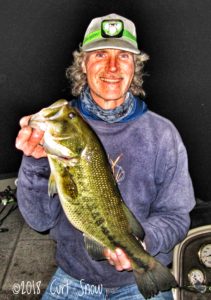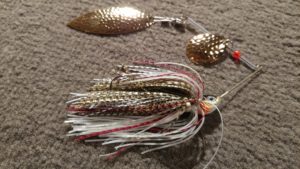 Night fishing for bass isn’t as popular as daytime fishing. But that doesn’t mean it’s not effective! Read on to learn how to make a spinnerbait for night fishing that will catch more bass than any other lure you choose to try.
Night fishing for bass isn’t as popular as daytime fishing. But that doesn’t mean it’s not effective! Read on to learn how to make a spinnerbait for night fishing that will catch more bass than any other lure you choose to try.
It’s no secret that big bass like to feed after dark, especially during the warmer months. Big bass are easier to fool after dark, since they are less able to detect anything about your lure that shows them that it’s not real.
As you set out to Make A Spinnerbait for Night Fishing, there are a few very important things you can do to make your spinnerbaits catch far more fish than spinnerbaits sold in stores. And that is exactly what we will be discussing in this article.
Bait Sizes
The size of the spinnerbait you throw after dark is one of the biggest factors that will help you catch bigger fish. When you Make A Spinnerbait for Night Fishing, it has to be bulky. It needs to be big enough to create a commotion that will get the attention of a big bass and get that bass to attack it.
The depth of the water you’ll be fishing will also be a factor. Deeper water will require a heavier bait. But it’s important to remember that deep is relative for whatever body of water you’re fishing. So, here’s a rule of thumb for night spinnerbait sizing.
If the water is 6 feet deep or less, a 1/2 oz. bait will be sufficient. If you’re fishing 6-12 feet, bump it up to a 3/4 oz. bait. Water deeper than this will require a 1 oz. bait, preferably with a bit smaller blade than you would use for shallow water. The smaller blade will allow the bait to stay down deeper where it can hug the bottom better.
Bait Color
 Night fishing spinnerbaits will almost always work best in dark colors. Black and purple are both good colors. Blades also don’t need to be bright, so there is no need to use bright, shiny blades when you Make A Spinnerbait for Night Fishing.
Night fishing spinnerbaits will almost always work best in dark colors. Black and purple are both good colors. Blades also don’t need to be bright, so there is no need to use bright, shiny blades when you Make A Spinnerbait for Night Fishing.
Brass blades are a great choice for night spinnerbaits because they don’t give off as much shine as the plated blades do. And a brass blade will usually get duller over time, making it more effective in low-light conditions.
Choosing the Right Wire
One of the biggest keys to making a spinnerbait that works well after dark is making sure that it gives off as much vibration as possible. Bass feed at night primarily by vibration, using the lateral line to detect motion and find their prey.
Heavy wire robs a lure of much of its vibration, so lighter wire is best. Stick to wires between .35 and .40 diameter. Keep in mind, also, that R-bend wire is better than the wire with the twisted eye when it comes to allowing the wire to vibrate as much as possible.
Best Blade for Night Fishing
 The undisputed king of blades for night fishing is the Colorado blade. A spinnerbait with a single Colorado blade will create far more vibration than any other blade style or combination.
The undisputed king of blades for night fishing is the Colorado blade. A spinnerbait with a single Colorado blade will create far more vibration than any other blade style or combination.
Blades in the size 6 – 8 range will work best, depending the depth you plan on fishing.
1/2 baits will work well with a size 6 or 7, while heavier baits will be better equipped with a size 7 or size 8.
Keep in mind that the depth you’ll be fishing will also come into play when choosing a blade size. Fishing water deeper than 8-10 feet is usually best done with blades in the size 6 or 7 range on a heavy bait. Bigger blades will tend to give the bait too much “lift”, causing it to rise out of the strike zone when retrieved.
Skirt Colors
As with the color of the lure body, the color of your skirt should also be dark. Black, or a combination of Black & Blue or Black & Purple will work well anywhere.
Sometimes it pays to experiment with other secondary colors to mix with the black. Red or blue will also work well.
Just remember that the primary goal of the skirt is to help present a bulky profile, so the darker colors help with creating that look by creating a better silhouette in low-light conditions.
What About The Swivel?
For the swivel, keep it simple. Use only a ball bearing swivel. You’ll want that large Colorado blade to spin easily. The best way to make sure that happens is by using a high-quality swivel that turns as easily as possible.
Putting it All Together
Once you’ve chosen your components and decided on the size of the lure you want to build, it’s time to assemble it all. You can watch the short video below for a quick how-to demo.
Once you’ve put a few of these together, go out and enjoy catching big bass after dark!
Items used for this project:
- Pre-Poured Spinnerbait Heads
- Spinnerbait Blades
- Spinnerbait Swivels
- Hollow Metal Beads
- Clevises
- Spinnerbait Spacer Tubes
- Spinnerbait Skirts
- Silicone Skirt Materials
If you enjoyed this post, please be sure to like it and share it with your friends.
And, as always, if you need any kind of lure-making supplies, be sure to visit our website, at http://lurepartsonline.com


